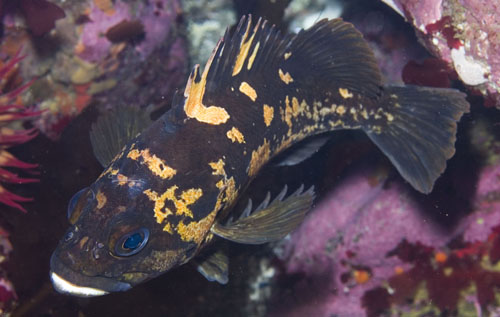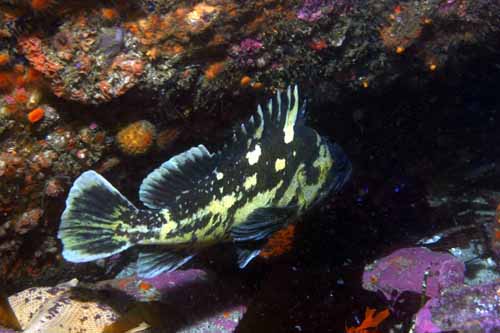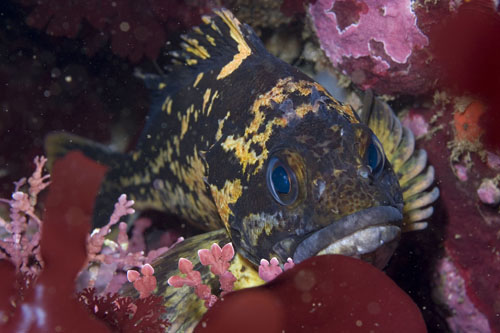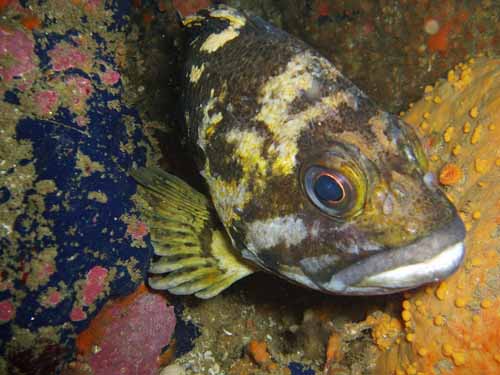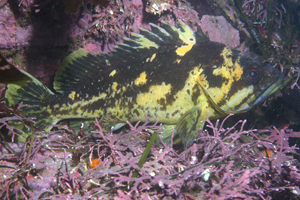
Black and yellow rockfish
Sebastes chrysomelas
Overview
Key Features:
Dark body with bright yellow splotches. Usually found in a crevice or under a rock overhang.Similar Species:
Gopher rockfish (Sebastes carnatus)China rockfish (Sebastes nebulosus)
Primary Common Name:
Black and yellow rockfishGeneral Grouping:
Bony fishesGeographic Range:
Eureka, California to Isla Natividada, Baja California, Mexico
Sebastes chrysomelas occurs from Eureka, California to Isla Natividada, Baja California, Mexico.Intertidal Height:
0 to 0 feet (0 to 0 meters)Subtidal Depth Range:
Minimum Depth: 0 meters or 0 feetMaximum Depth: 37 meters or 123.21 feet
Notes:
Sebastes chrysomelas occurs mostly in the shallow subtidal.Habitats:
kelp forestNotes:
Sebastes chrysomelas is mostly a demersal, bottom dwelling, fish that is found around rocky reefs or near kelp beds. They occur from the intertidal down to 37 m, but are most common in waters less than 18 m.Abundance:
Relative Abundance:
Sebastes chrysomelas is common from the intertidal to 18 m in depth. They are less commonly found south of San Diego, California.Species Description:
General:
Sebastes chrysomelas belongs to the family Scorpaenidae, the Scorpionfishes and Rockfishes. The genus name Sebastes means magnificent in Greek and the species name chrysomelas means black and yellow in Latin. Sebastes chrysomelas and the Gopher Rockfish, Sebastes carnatus, highly resemble each other and are often found together. However, they do segregate somewhat by depth with the more aggressive Sebastes chrysomelas excluding Sebastes carnatus from shallower waters.Distinctive Features:
Sebastes chrysomelas is a heavy bodied, thick rockfish with 5 pairs of large head spines. The body is black or dark brown, with a paler belly and yellow to orange blotches on its back. The yellow and orange blotches are the major feature that distinguishes this species of rockfish from others. It has faint, dark stripes that radiate from the eyes. Its snout is moderately sharp and its lower lip is dark gray. The lower pectoral fin rays are fleshy and there are 6 – 7 anal fin soft rays. The dorsal fin is continuous, deeply notched and the spiny portion is longer-based, with incised membranes.It is virtually indistinguishable from Sebastes carnatus with the exception of the yellow blotches in contrast to the pink or white blotches on Sebastes carnatus. The China Rockfish, Sebastes nebulosus, is similar to Sebastes chrysomelas but can be distinguished by a continuous, broad yellow stripe along the side of its body.
Size:
Sebastes chrysomelas grow to a lenth of 39 cm.Natural History:
General:
Sebastes chrysomelas is generally a solitary, territorial and residential fish. They have homing ability and after establishing residence, they rarely travel more than 2 km from their home range. They have been aged to 22 years. This species has mildly venomous dorsal and anal spines that can cause a painful wound. In the past, this rockfish was rarely taken in the commercial catch, however, in recent years a fishery has developed for them.Predator(s):
Sebastes chrysomelas is targeted by hook and line commercial fishermen for the market and restaurant live fish trade and also taken recreationally by anglers. Sharks, dolphins and seals all prey on adult Sebastes chrysomelas. Birds, porpoises and fishes, including rockfishes, lingcod, Ophiodon elongatus, cabezon, Scorpaenichthys marmoratus and salmon all feed on juvenile Sebastes chrysomelas.Prey:
Sebastes chrysomelas feeds on a variety of crustaceans, mollusks and fishesFeeding Behavior:
CarnivoreNotes:
Sebastes chrysomelas is a nocturnal feeder, ambushing its prey between dusk and dawn.Seasonal Behavior
February - July
Reproduction:
Sebastes chrysomelas is a viviparous, live-bearing, fish. Females mature between 3 and 6 years of age and males between 3 and 4 years of age. Spawning takes place from February to the end of July with peak spawning in February and March. Females may be carrying fertilized eggs anytime between October and the end of February. The first young of year appear in kelp beds in May and June. They are usually first observed in the kelp canopy among the fronds. They later descend down the plant and eventually settle closer to the bottom leaving the protection of the kelp.References
- Boschung, H.T., J.D. Williams, D.W. Gotshall, D.K. Caldwell, and M.C. Caldwell. 1998. National Audubon Society Field Guide to North American Fishes, Whales and Dolphins. A.A. Knoph, New York, NY. 848 p.
- Eschmeyer, W.N., and E.S. Herald. 1983. A Field Guide to Pacific Coast Fishes of North America. Houghton Mifflin Company, Boston, MA. 336 p.
- Froese, R. and D. Pauly (eds.). 2006 (Updated 01/02/06). FishBase. World Wide Web electronic publication. http://www.fishbase.org, Accessed [04/25/06].
- Gotshall, D. 2005. Guide to marine invertebrates : Alaska to Baja California. Sea Challengers, Monterey, CA. 117 p.
- Love, M. 1996. Probably more than you want to know about the fishes of the Pacific Coast. Really Big Press, Santa Barbara, CA. 381 p.
- State of California. 2003. California Department of Fish and Game, Marine Region, Nearshore Finfish Profiles. World Wide Web electronic publication. http://www.dfg.ca.gov/mrd/rockfish/index.html, Accessed [09/30/06].
Related Information
Photo Library
Click on an image below to view a larger version in the SIMoN Photo Library. You will also be able to view important information on each photo such as photographer, date, caption and more

